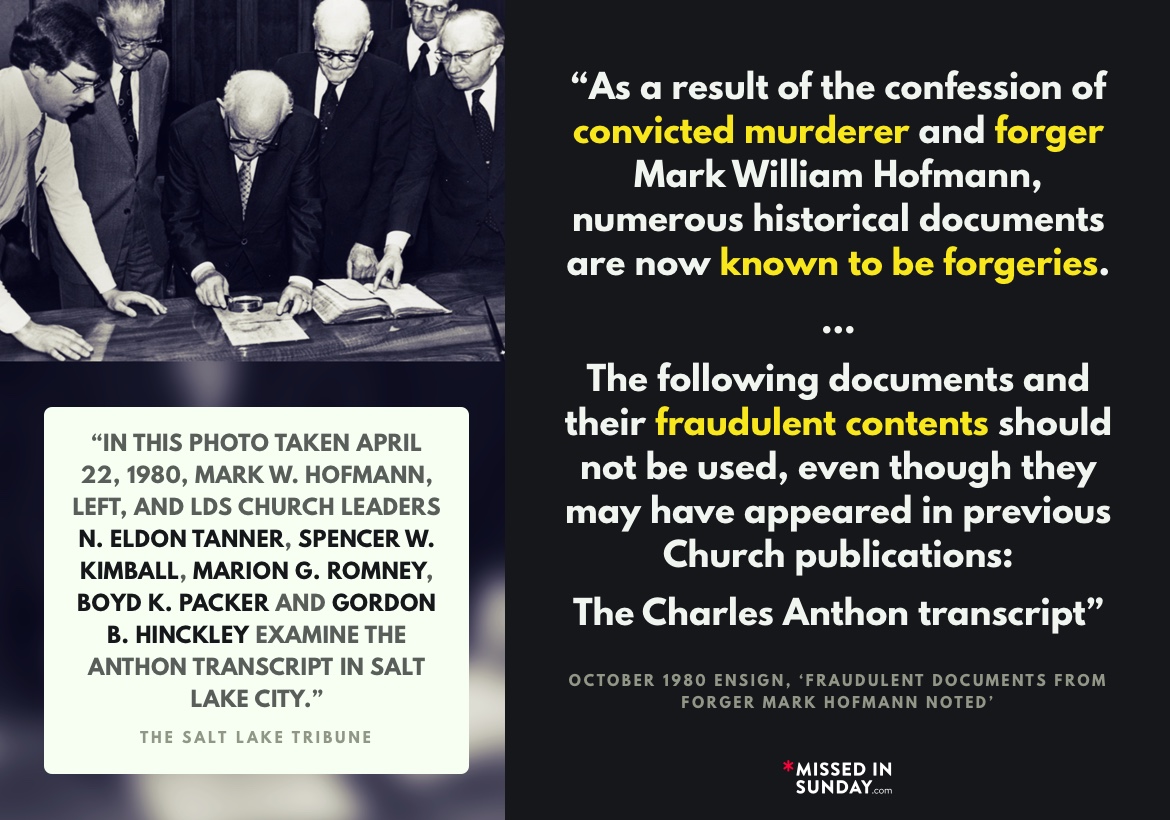From the Salt lake Tribune via AP:1
In this photo taken April 22, 1980, Mark W. Hofmann, left, and LDS Church leaders N. Eldon Tanner, Spencer W. Kimball, Marion G. Romney, Boyd K. Packer and Gordon B. Hinckley examine the Anthon transcript in Salt Lake City. Back in October 1985, when Hofmann killed two people with homemade pipe bombs in an attempt to divert attention from his double-dealing and dishonesty, the Utah-based church restricted access to its historic archives and promoted only a canonized — some would say narrow — view of the faith’s founding. No more. The Church of Jesus Christ of Latter-day Saints has opened its archives, posted thousands of documents online, produced groundbreaking research on its past and published a dozen recent essays on controversial historical developments.
From the October 1980 Ensign, ‘Fraudulent Documents from Forger Mark Hofmann Noted’: 2
As a result of the confession of convicted murderer and forger Mark William Hofmann, numerous historical documents are now known to be forgeries.
The announcements and texts of some of these documents were published in Church periodicals, and the documents have been used in good faith since 1980 in manuals and discussions by leaders, teachers, and members of the Church. The following documents and their fraudulent contents should not be used, even though they may have appeared in previous Church publications:
The Charles Anthon transcript, purportedly reformed Egyptian characters copied by Joseph Smith from the Book of Mormon gold plates in 1828. (See Ensign, Jun. 1980, July 1980, Dec. 1983.)
The Joseph Smith III blessing, falsely represented as a father’s blessing given by the Prophet Joseph Smith on 17 January 1844 to his son, Joseph Smith III, to the effect that this son was his appointed successor. (See Ensign, May 1981.)
The Lucy Mack Smith letter of 23 January 1829, falsely said to have been written by Joseph Smith’s mother. It presents details that purportedly came from the 116 lost manuscript pages of the Book of Mormon, including the idea that Ishmael, whose daughters married the sons of Lehi and Sariah, was the brother of Sariah. (See Ensign, Oct. 1982, Dec. 1983.)
The Martin Harris letter of 13 January 1873 to Walter Conrad, purportedly in the handwriting of Martin Harris’s son, Martin Harris, Jr., and signed by Martin Harris, who would have been eighty-nine years old at the time. This fraudulent text reaffirms the testimony of Martin Harris as one of the Three Witnesses to the Book of Mormon. (See Ensign, Nov. 1982, Dec. 1983.)
The David Whitmer letter of 2 April 1873 to Walter Conrad, ostensibly written by another of the Three Witnesses to the Book of Mormon, fraudulently reaffirming David Whitmer’s testimony. (See Ensign, Dec. 1983.)
Two pages of the original manuscript of the Book of Mormon, covering Helaman 14:20 to 15:12, as well as parts of Mosiah 2:6–7 and 2:17–18, ostensibly written by Oliver Cowdery as Joseph Smith dictated the translation. (See Ensign, Oct. 1983, Dec. 1983.)
The E. B. Grandin contract of 17 August 1829, falsely purported to be a financial agreement between printer Egbert B. Grandin and Joseph Smith for the first printing of the Book of Mormon. (See Ensign, Dec. 1983.)
A “Joseph Smith, Jr.” signature in a first-edition copy of the Book of Mormon. While the signature is a Mark Hofmann forgery, a Joseph Smith letter on virtue mentioned in the same news article was from another source and is considered authentic. (See Ensign, Sept. 1985.)
The Martin Harris letter (popularly known as the white salamander letter), purportedly written in 1830 by Martin Harris to William W. Phelps. This letter contains a spurious account of problems encountered by Joseph Smith in obtaining the gold plates.
The Josiah Stowell letter, purportedly written by Joseph Smith in 1825. It contains information indicating Joseph Smith was involved in folk magic. Before being labeled a forgery, this letter was believed to contain the earliest surviving handwriting of the Prophet.
Mark Hofmann also claimed to be in the process of purchasing a collection of writings by William E. McLellin, one of the original members of the Council of the Twelve, who later apostatized and lost his membership in the Church, but who never recanted his testimony of the Book of Mormon. (See Ensign, Feb. 1986.) Although documents written by William E. McLellin may exist, Hofmann has confessed that his own professed “collection” does not.
Hofmann was also the source of a widely circulated rumor concerning an early history by Oliver Cowdery purportedly owned by the Church. This nonexistent history falsely credits Joseph Smith’s brother Alvin with a role in obtaining the gold plates. (See the Church’s disclaimer in the Ensign, Dec. 1986; see also Ensign, Aug. 1987.)
See also:
References
| 1 | ‘Revolution’ in LDS Church approach to history – http://www.standard.net/Faith/2015/10/23/Revolution-in-LDS-Church-approach-to-history |
|---|---|
| 2 | October 1980 Ensign – https://www.lds.org/ensign/1987/10/news-of-the-church/fraudulent-documents-from-forger-mark-hofmann-noted?lang=eng |

